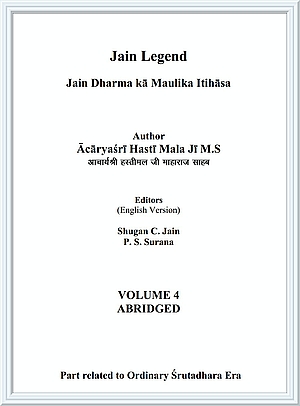In the third volume of the present Jain History, citing authentic inscriptions and historical events, it was elaborately described that during the rule of Gaṃga, Kadamba, Rāṣṭrakūṭa and Hoysala dynasties, there was remarkable accretion in Jainism in general and Jain congregation of South, in particular. During their regime, Jainism was reckoned as one of the most important religions of the South. From the 2nd to the 7th century AD, Jain religion was considered as the most dominant, well-accepted and influential religion. The Western Cālukyas established their rule after King Indra IV of the Rāṣṭrakūṭa dynasty, who embraced a holy death observing the vow of fast unto death (Saṃlekhanā) in V.N. 1501 (974 AD).
The progress of Jain religion was impeded during the regime of western Cālukyas. Unlike earlier kings, the western Cālukyas did not patronise Jain religion. Hence it slowly went into subaltern position. The idols of Jain deities were removed and thrown out from Jain temples. Śiva or Viṣṇu idols of Hindu mythology were installed in their place. Verily such situation did not last for long.
In 1126 AD, Kalcurī King Vijjala ascended the throne of Cālukya and proclaimed himself as an emperor. During the early regime of Vijjala, Jain religion once again started growing in popularity. Vijjala himself was a Jain. During that time Jain congregation had reinstated its lost power and once more started taking the shape of a strong and powerful religion. In actuality the domination of the Jain religion was like a flickering light. A minister of emperor Vijjala, by the name Basavā, secretly started propagating Liṃgāyata religion and to achieve his end he extravagantly spent money from the treasury of Kalyāṇī. When Vijjala came to know that his minister Basavā was immorally expending huge amounts from the royal treasury to promote and spread Liṃgāyata religion, the king took over the treasury into his custody.
Enraged by this act, Basavā deceitfully poisoned King Vijjala and killed him. When the sons of Vijjala tried to kill Basavā, the guilty Basavā fled and escaped from there. The princes with their soldiers chased Basavā. On reaching Dhārawāḍa, when Basavā saw that the princes and the army were chasing him, left with no option he jumped into a well and died. However, he was considered valiant person who had sacrificed his life for the sake of his religion.
Liṃgāyatas rose in revolt against the king and started massacring the followers of Jainism. The revolutionary songs written by Liṃgāyata ascetics created such a profound influence in the hearts of people that many untold atrocities on Jains in the vast territories of Kalcurī kingdom took place. Liṃgāyatas forcibly and collectively converted the merchant (vaṇiṃjaka) class who were loyal followers of Jainism for centuries and the entire creed as their followers into their religion. This resulted not only in a significant reduction in the number of followers of Jainism but diversion of monetary contribution / donation from Jainism to Liṃgāyatas. The Jain ascetics become ineffective to the extent that they could not even propagate their religion.
The leaders of Liṃgāyata spread such folk tales in Karnataka and Andhra Pradesh, which boosted the morale of Liṃgāyatas and killed Jain monks. These folk songs and folk tales, in a way totally wiped out Jainism from Andhra Pradesh.
Even in these calamitous conditions Jain religion did not disappear completely in Karnataka as a large number of loyal Jain monks and followers existed there still. The kings from the North of Mysore helped the Jain followers from time to time. Even the alien rulers were somewhat generous towards Jains, for example, Haidara Nāyīka who donated a village to Jain temples.
Around 1326 AD, the Muslim conquerors defeated and destroyed Hoysala dynasty. The anarchy created by the Muslim attacks and invasions gave rise to a powerful Hindu kingdom in Vijayanagara. The Cālukya kings of Vijayanagara were mostly followers of Vaiṣṇavism and most of their ministers were Brahmins. Hence Jain followers could not get any opportunity to establish their influence over there. Nevertheless they protected the Jains against the religious campaigns led by Vaiṣṇavites. None of the rulers of Vijayanagara ever harassed the Jains. On the contrary, they safeguarded the Jains during times of calamity.
To cite an example, during the regime of Bukkarāya of Cālukya dynasty which extended from 1353 to 1377 AD, a historical concordat between the Jains and Vaiṣṇavites was made which helped the followers of Jainism in adverse times. This is a laudable paradigm which never happened anywhere in the world. The views expressed by Dr. P.B.Desai, in his historical text 'A History of Karnataka' about the discipline of Bukkarāya are given below.
 Acharya Hasti Mala
Acharya Hasti Mala
